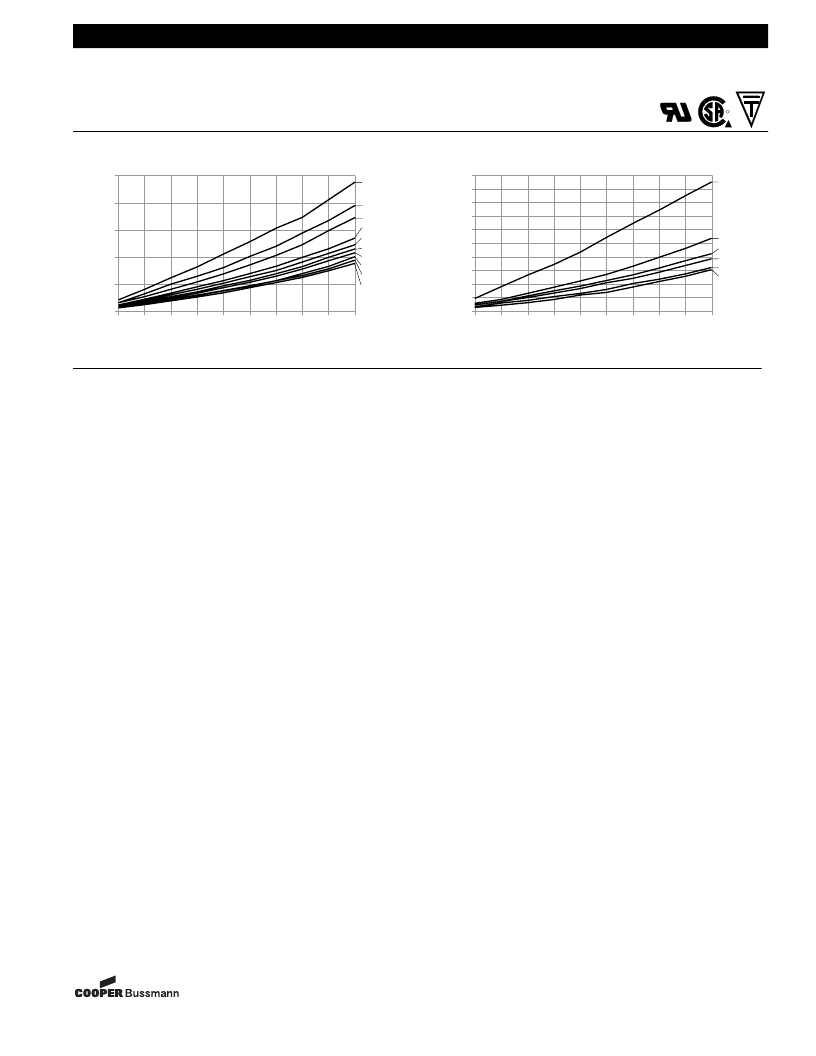- 您現(xiàn)在的位置:買賣IC網(wǎng) > PDF目錄369471 > BKMCR-7 Fuse PDF資料下載
參數(shù)資料
| 型號(hào): | BKMCR-7 |
| 元件分類: | 保險(xiǎn)絲 |
| 英文描述: | Fuse |
| 中文描述: | 保險(xiǎn)絲 |
| 文件頁(yè)數(shù): | 2/2頁(yè) |
| 文件大?。?/td> | 35K |
| 代理商: | BKMCR-7 |

12-21-98
SB98107
Rev. A
Mic rotron
Printed Circ uit Board Fuses
.122∑ ≈ .297∑ (3.10mm ≈ 7.54mm)
MCR
Bussmann
Form No. MCR
Page 2 of 2
BIF Doc #2003
The only controlled copy of this BIF document is the electronic read-only version located on the Bussmann Network Drive. All other copies of this document are by definition uncontrolled. This bulletin
is intended to clearly present comprehensive product data and provide technical information that will help the end user with design applications. Bussmann reserves the right, without notice, to change
design or construction of any products and to discontinue or limit distribution of any products. Bussmann also reserves the right to change or update, without notice, any technical information con-
tained in this bulletin. Once a product has been selected, it should be tested by the user in all possible applications.
R
V
2
1.8
1.6
1.4
1.2
1
0.8
0.6
0.4
0.2
0
10% 20% 30% 40% 50% 60% 70% 80% 90% 100%
Percent of Rated Current
MCR-
§
MCR-
MCR-
MCR-
¢
MCR-
¢
V
0.25
0.2
0.15
0.1
0.05
0
10% 20% 30% 40% 50% 60% 70% 80% 90% 100%
Percent of Rated Curent
MCR-1
MCR-1
MCR-2
MCR-2
MCR-3
MCR-3
MCR-5
MCR-10
MCR-4
MCR-7
Typical Voltage Drop (At 25° C Ambient Temperature)
Body
High temperature thermoplastic,
flammability rating UL 94 VO.
Electrical Characteristics
Carry 100% rated current for 4 hours
minimum. Open at 250% of rated
current in 5 seconds maximum.
Element
Solid Matrix, gold or silver element
encapsulated in ceramic.
Leads
Tin-plated copper .64mm (.025
∑
)
diameter.
Lead Bend Test
With a two pound weight attached, 90°
one direction, back to original position,
then 90° opposite direction; fuse will
withstand two cycles.
Life Test
2000 hours at 80% rated current,
55°C.
Moisture Resistance
MIL-STD-202, Method 106, 90%
relative humidity at 65°C.
Operating Temperature
-55°C to 125°C with proper fuse
derating.
Packaging
EIA-STD-296-E.
Resistance to
Soldering Heat
Salt Spray
MIL-STD-202, Method 210, Test
Condition C (260°C).
MIL-STD-202, Method 101, Test
Condition B.
MIL-STD-202, Method 213, Test
Condition I, 100G’s for 6 milliseconds.
MIL-STD-202, Method 208.
MIL-STD-202, Method 211, Test
Condition A, will withstand 7 lb. axial pull
test.
MIL-STD-202, Method 107, Test
Condition B, -65°C to 125°C.
EIA-STD-RS-186-C, Test Condition A,
-55°C to 85°C.
MIL-STD-202, Method 204, Test
Condition C, (55 to 2000 HZ, 10G’s
peak).
Maximum reservoir temperature 260°C,
10 second maximum exposure, .125"
from body.
Shock
Solderability
Terminal Strength
Thermal Shock
Thermal Cycle
Vibration
Wave Soldering
Microtron fuses are designed to meet the following specifications:
相關(guān)PDF資料 |
PDF描述 |
|---|---|
| BKMCR-10 | Fuse |
| BKMCR-2 | Fuse |
| BKMCR-3 | Fuse |
| BL-C2336 | Optoelectronic |
| BL64-401 | FILTER REGLER OELER SYSTEINHEIT 0.5ZOLL |
相關(guān)代理商/技術(shù)參數(shù) |
參數(shù)描述 |
|---|---|
| BK-MDA-1 | 制造商:Cooper Bussmann 功能描述:FUSE 1A 250V FERRULE - Bulk 制造商:Cooper Bussmann 功能描述:FUSE 1A 250V T-LAG CRM MDA |
| BK-MDA-10 | 制造商:Cooper Bussmann 功能描述:Fuse Miniature 10A 250V Slow Blow 2-Pin Cartridge Holder Cardboard Carton 制造商:Cooper Bussmann 功能描述:FUSE 10A 250V FERRULE - Bulk 制造商:Cooper Bussmann 功能描述:FUSE 10A 250V T-LAG CRM MDA |
| BK-MDA-10NX | 功能描述:保險(xiǎn)絲 SMALL DIMENSION FUSE RoHS:否 制造商:Littelfuse 產(chǎn)品:Surface Mount Fuses 電流額定值:0.5 A 電壓額定值:600 V 保險(xiǎn)絲類型:Fast Acting 保險(xiǎn)絲大小/組:Nano 尺寸:12.1 mm L x 4.5 mm W 安裝風(fēng)格: 端接類型:SMD/SMT 系列:485 |
| BK-MDA-10-R | 制造商:Cooper Bussmann 功能描述:Fuse Miniature 10A 250V Slow Blow 2-Pin Cartridge Holder Cardboard Carton 制造商:Cooper Bussmann 功能描述:FUSE 10A 250V FERRULE - Bulk 制造商:Cooper Bussmann 功能描述:FUSE 10A 250V T-LAG CRM MDA 制造商:Cooper Bussmann 功能描述:Time Delay 6.3 x 32 mm 250 VAC 10 A Ceramic Cartridge Fuse |
| BK-MDA-10-R-TC | 制造商:Cooper Bussmann 功能描述:MDA 10A BUSS TD BK, TIGHTER CAP - Tape and Reel |
發(fā)布緊急采購(gòu),3分鐘左右您將得到回復(fù)。